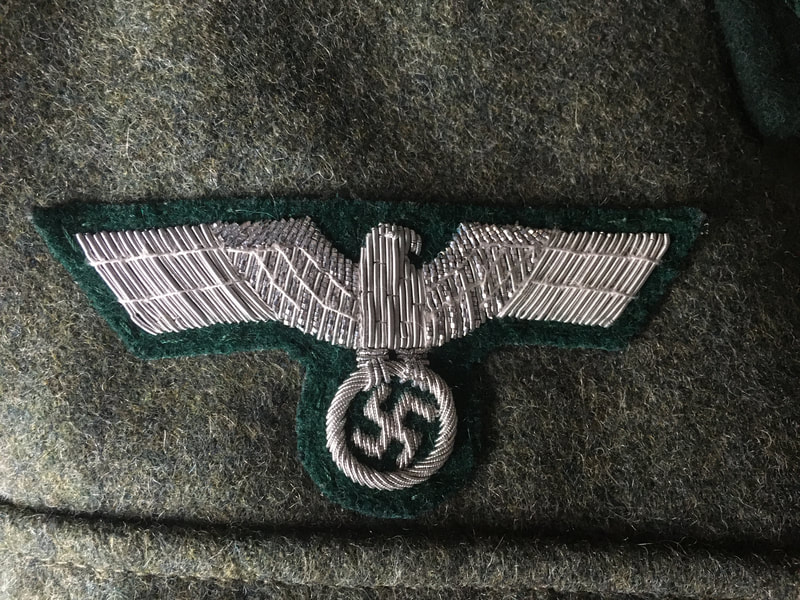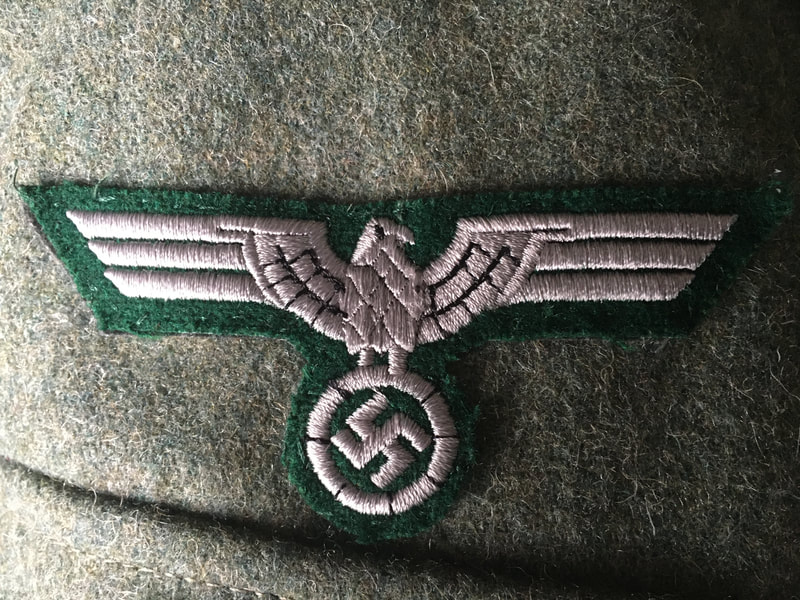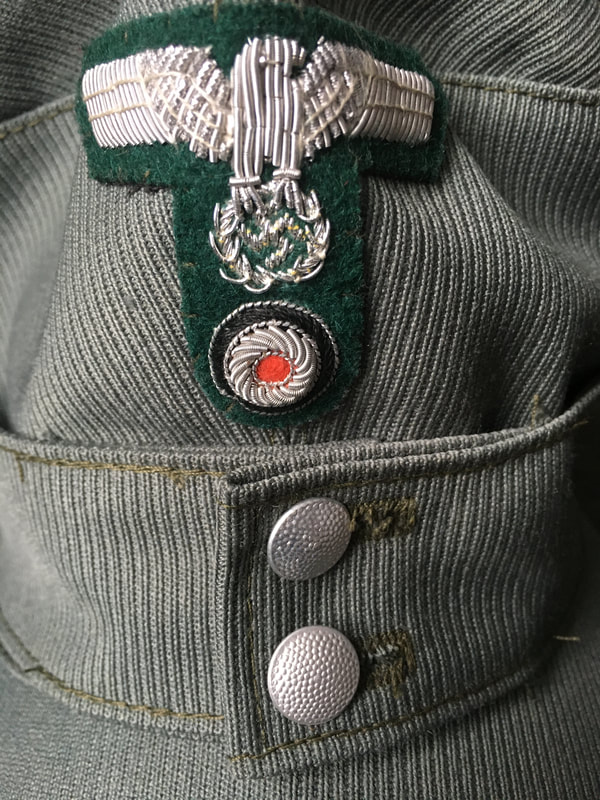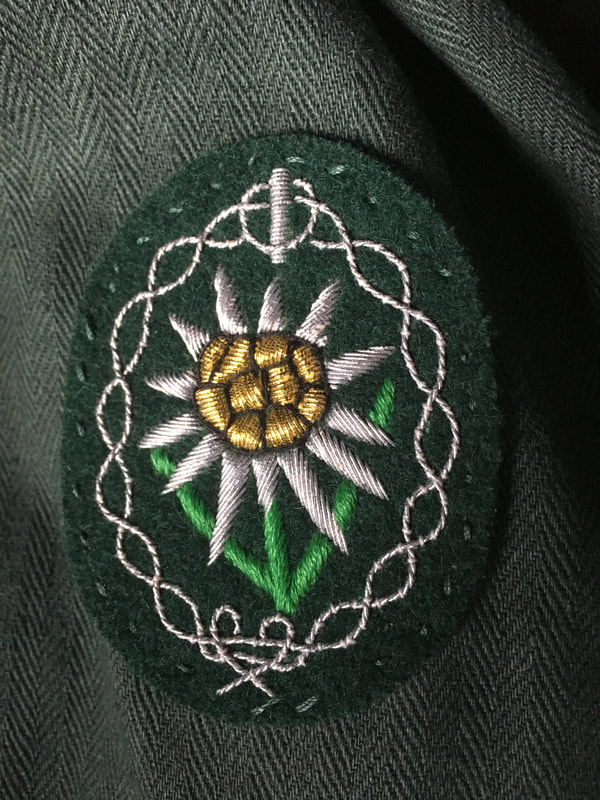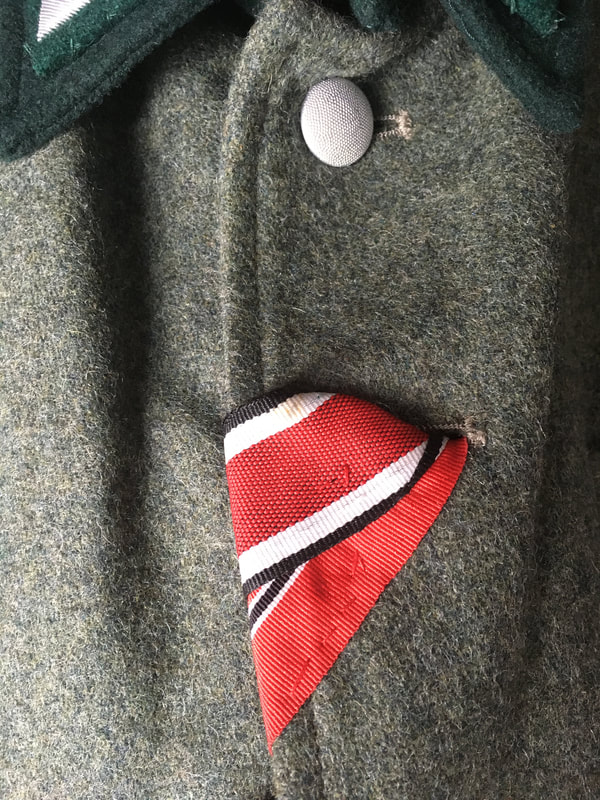Other Insignia & Awards
Breast Eagles were insignia worn above the right pocket on a Feldbluse. In general, officer eagles were made of silver/aluminum thread or bullion, and Enlisted/NCO eagles were made of white, off-white or subdued material. Heer (Army) eagles were bordered in green (Heer Panzer were bordered in black), and were of a different design than Luftwaffe and Waffen SS eagles (SS were worn on the left sleeve, not the breast).
See below: Left is Officer Silver Bullion and Right is Enlisted/NCO Wool.
See below: Left is Officer Silver Bullion and Right is Enlisted/NCO Wool.
Cap Eagles were bordered in green, contained the Heer Eagle and the national cockade below it. Gebirgsjägers often preferred Steinmuss wooden buttons. Officer caps generally had silver buttons. The Gebirgsjäger Bergmutz shown here was the inspiration for the M43 service cap adopted by all branches. The M43 had a longer brim and a shorter peak.
Below: Officer (Left) and Enlisted/NCO (Right)
Below: Officer (Left) and Enlisted/NCO (Right)
The Bergmutz also featured a metal Edelweiss on the left side. Austrian tradition had a green backing (seen here). Mountain caps could also feature pins commemorating the division insignia. The 2. Geb. insignia adopted after the Norwegian campaign was the Reindeer. Cap Edelweiss produced during the war had a slightly different design--most notable in the stem leaf-- than those produced after the war and which most reproductions seem to be based from.
Below Left: Original WWII. Bottom Right: Original Post-war. The bottom stem leaf does not curl at the end and the top stem leaf stops at the first flower petal.
Below Left: Original WWII. Bottom Right: Original Post-war. The bottom stem leaf does not curl at the end and the top stem leaf stops at the first flower petal.
Edelweiss Sleeve Insignia were worn on the right sleeve. Again, there were officer versions and Enlisted/NCO versions...Top Left and Right are original EM/NCO versions. Bottom Left is reproduction Enlisted/NCO and Bottom Right is reproduction officer.
Awards for acts of valor on the field followed a progression: Iron Cross 2nd Class (EK2), Iron Cross 1st Class (EK1), German Cross in Gold or Silver (DK), Knights Cross of the Iron Cross (Ritterkreuz or "RK"). The DK and RK could also be awarded to senior leaders based on their campaign leadership and success. This is a simplified explanation.
The EK2 when worn on dress occasions had a ribbon attached and was worn from the second button hole. All other times only the ribbon was worn in the button hole. The EK1 was worn on the left Feldbluse pocket, the German Cross was worn on the right Feldbluse pocket, and the Ritterkreuz was worn around the neck under the Feldbluse collar.
Below, Left to Right: original EK2, reproduction EK1, reproduction DK in Gold and reproduction Ritterkreuz.
The EK2 when worn on dress occasions had a ribbon attached and was worn from the second button hole. All other times only the ribbon was worn in the button hole. The EK1 was worn on the left Feldbluse pocket, the German Cross was worn on the right Feldbluse pocket, and the Ritterkreuz was worn around the neck under the Feldbluse collar.
Below, Left to Right: original EK2, reproduction EK1, reproduction DK in Gold and reproduction Ritterkreuz.
Top Row L-R: (all originals) Wound badge in Black, Ostfront Medal, Ostfront ribbon with EK2 ribbon
Middle Row L-R: Infantry Assault Badge, Proper arrangement with EK1, Narvik Shield (Silver)
Middle Row L-R: Infantry Assault Badge, Proper arrangement with EK1, Narvik Shield (Silver)
|
ORIGINAL AWARD CRITERIA
|
RE-ENACTING CRITERIA
|
|
WOUND BADGE: Verwundetenabzeichen
INFANTRY ASSAULT BADGE: Infanterie Sturmabzeichen
The silver class was instituted on 20 December 1939 was awarded to infantry soldiers who took part in at least three: infantry assaults (including counter-attacks) or at least three armed reconnaissance operations or engaged in hand-to-hand combat in an assault position or participated on three separate days in the reestablishment of combat positions. The bronze class was instituted on 1 June 1940 and was awarded to motorized/Mechanized Infantry troops according to the same criteria. |
WOUND BADGE: Verwundetenabzeichen
It would be unusual to have received Iron Crosses or Close Combat Clasps without having been wounded, therefore we award wound badges as part of that award for valor progression. Since participant safety is paramount, we don't think it's appropriate to mirror the original criteria, but if someone is injured during a field exercise with the "enemy", it can be awarded. INFANTRY ASSAULT BADGE: Infanterie Sturmabzeichen
We award the IAB in Silver after 3 separate events with field exercises. |
|
IRON CROSS: EISERNE KREUZ
The EK2 was awarded for a single successful action in which the soldier distinguished himself. For example, a platoon leader who led a reconnaissance mission wherein a firefight ensued, defeating the enemy force and bringing back several prisoners of NCO rank or higher. The EK1 was awarded for 3 or 4 additional acts of bravery apart from the action that brought the EK2. Erwin Rommel, for example, was awarded his EK1 during WWI while leading his men in an assault on an enemy position. His company was accidentally left unsupported against a superior force. To retreat or remain in place until help would arrive would have been as dangerous as to continue the attack. Rommel chose to continue the attack, and succeeded in taking the original objective. |
IRON CROSS: EISERNE KREUZ
Example of an EK2 award: One of our machine gunners had consistently performed successfully over several events, both in offense and defense. In the following event, the unit was severely understrength and the gunner covered a retreating flank alone. This succession earned him the EK2. For the EK1, this is more common when senior NCOs complete several successful missions over time. |
|
Eastern Front Medal: OSTMEDAILLE
Created on 26 May 1942, "in recognition of experience in the struggle against the Bolshevik enemy and the Russian winter within the period from 15 November 1941 to 15 April 1942." It was also awarded posthumously to any service member who died in the line of duty within the Soviet Union. It was wryly called the Frozen Meat Medal or the "Order of the Frozen Flesh". Requirements called for a minimum of 14 days in active combat; 30 air combat sorties; 60 days continuous of service in a combat zone; being wounded or suffering a "frozen limb", severe enough to warrant the issue of a Wound Badge, and it could be awarded posthumously. NARVIK SHIELD
Members of the Gebirgsjäger, Luftwaffe and Kriegsmarine who participated in the combat for Narvik were eligible. Only 2,755 were awarded to the army out of a total of just 8,577 across the three branches. A recipient must have performed distinguished service above and beyond. |
Eastern Front Medal: OSTMEDAILLE
We award this after 2 winter/cold weather events. NARVIK SHIELD
Based on the small number actually awarded during the campaign, this award is currently retired, though members who were awarded it several years ago may continue to wear it. |
